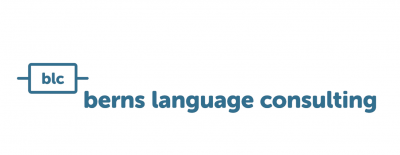Defining a strategy for your company’s language processes is not as complicated as it sounds. We all constantly create strategies in our daily lives, e.g. investment strategies to increase our cash flow or nutrition strategies to become healthier or leaner.
A strategy aimed at a company’s language processes ensures that we focus the right language topics in the right direction. With a clear strategy, it is easy to decide whether, for example, a translation management system is purchased, terminology workflows are set up or extended, or machine translation is used.
With a clear strategic focus when answering such questions, we contribute perfectly to our company’s success. It stands to reason that when doing so, other factors come into play than when defining a much simpler diet strategy.
But let’s start at the beginning: What does “strategy” mean and where does the term come from?
The term “strategy” is derived from the Greek word “strategos” and is composed of the two words “stratos” (army) and “agein” (to lead). In ancient Greece, “Strategos” were the chief army leaders.
(Source St. Gallen Business School)
The term ‘strategy’ is therefore martial!
This fits well in that some fighting and conquest spirit and a lot of perseverance are very useful in developing and pursuing a strategy. And even though academic writings on strategy still deal with “war scenarios”, today’s implementation of strategy is moving in a more constructive and peaceful direction. In the end, we do not want to conquer, but convince with results!
The one or no strategy?
Spoiler alert! There is neither the one nor the best strategy. And everything is better than having no strategy at all!
Many companies already have extensive material on the high-level corporate strategy, i.e. vision, mission, values, and strategic guidelines are defined across companies. Unfortunately, these statements are often too abstract, so much so that a connection to one’s own activities does not always become clear.
There we already have the first, important task in designing a language process strategy for the company: The corporate strategy should be used as an anchor point to align your language process strategy.
When aligning the language process strategy with the corporate strategy, one should always ask oneself whether the language process strategy supports the corporate strategy!
But how do I start with strategy work?
The first crucial question here is how the basic approach should be when designing the strategy:
- Should it be a “top down” strategy approach, defined by management and a small group which then dictates the strategy to the rest of the team?
- Or should it be a team of representatives of employees, internal customers, and partners, such as purchasing or IT, that shape the strategy “bottom-up”?
Next spoiler alert: If the corporate culture allows it, then a “bottom-up” strategy process with representatives of all relevant stakeholder groups is recommended, because this way, the essential change process, which is required for a successful implementation of your strategy, is initiated in parallel.
Strategy work benefits from different knowledge from inside your company as well as from outside (from the market, from experts).
If you want to do this, you should first think about who you need in your strategy team. And of course, you always need management support if you want to implement a strategy successfully. All of this is easiest to find out in a stakeholder analysis!
Once your strategy team is established and everyone involved is on board, the actual strategy work can finally begin.
Yes, strategy is work, but important work!
A strategy is not simply pulled out of your sleeve; it takes time to think about external and internal factors that influence a strategy, consider the corporate strategy, consult relevant stakeholders, and shape strategic goals. Also, the vision, that is, the North Star, the beacon that your strategy is aimed at in the long term, is not quickly defined.
A tip here: It is not useful to get lost in wild word creations here, even if linguists like us love to do so ;-). A strategy does not have to be beautiful, sound amazing, or be perfectly formulated; above all, it has to work.
Strategy works when all employees understand it as a clear framework for action and can relate their actions to the strategic goals that have been formulated.
For example, let’s suppose, a strategic goal for a language department is to promote language process automation to handle translation volumes faster. In this case, a decision to e.g. implement machine translation is not an individual decision, but a strategic one, because it supports the strategic goal.
Even better, if one of the company’s goals is to make internal processes 20% more efficient, then this goal is directly linked to the company’s overall strategic goals and anchored deeply in the company’s strategy.
In negotiations with management, e.g. for budget when introducing translation systems, such strategic links are unbeatable arguments when for example accompanied by a sound business case.
Nothing (strategically) good happens, unless you do it
Having no strategy is unfortunate because it means that, in the worst case, people without goals work in opposite directions.
A strategy should not be complicated at all, but should concentrate on the essential objectives! Be careful not to create too many strategic goals, lest you lose focus and create dissatisfaction because not everything can be achieved at the same time.
Against dissatisfaction and for maximum focus, the strategic goals should also be cut into smaller slices, because strategic goals have a long-term effect (2-4 years). The best way to do this is to derive operational targets from the strategic objectives that have a short-term effect (month, quarter, year). These must then be followed up and discussed regularly, so someone should be responsible for monitoring these objectives (not for achieving them, for this each individual is responsible).
All this ensures that your strategic objectives are achieved in the end and that the energy in your team does not dissipate.
And how to best implement strategy work?
Personally, I prefer agile methods for strategy work both for other companies and at my own: I like to build a Strategy Map for strategic goal visualization, vision, and mission, and use Kanban for operational implementation via strategy sprints and squads.
In my digital strategy workshops (sometimes also for parts of my face-to-face workshops), I like to use MIRO or similar tools. But strategy work can also be done the classic way, with Excel, and PowerPoint, or in a hybrid form. The choice of tools depends heavily on the company, team, and corporate culture, but is not critical for success.
The essential thing is that the results are convincing and the strategy is understandable and comprehensible for all. Then the strategy will develop such a strong ‘pull’ that it will transport everyone toward the vision!
Would you like to know more about the strategy consulting that we already did for other companies? Do you need strategic advice? Get in touch! We are happy to help!






